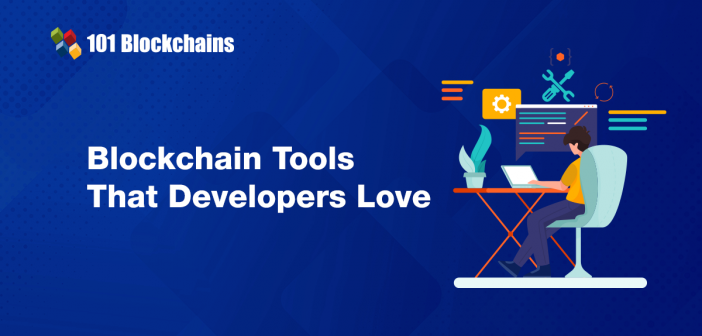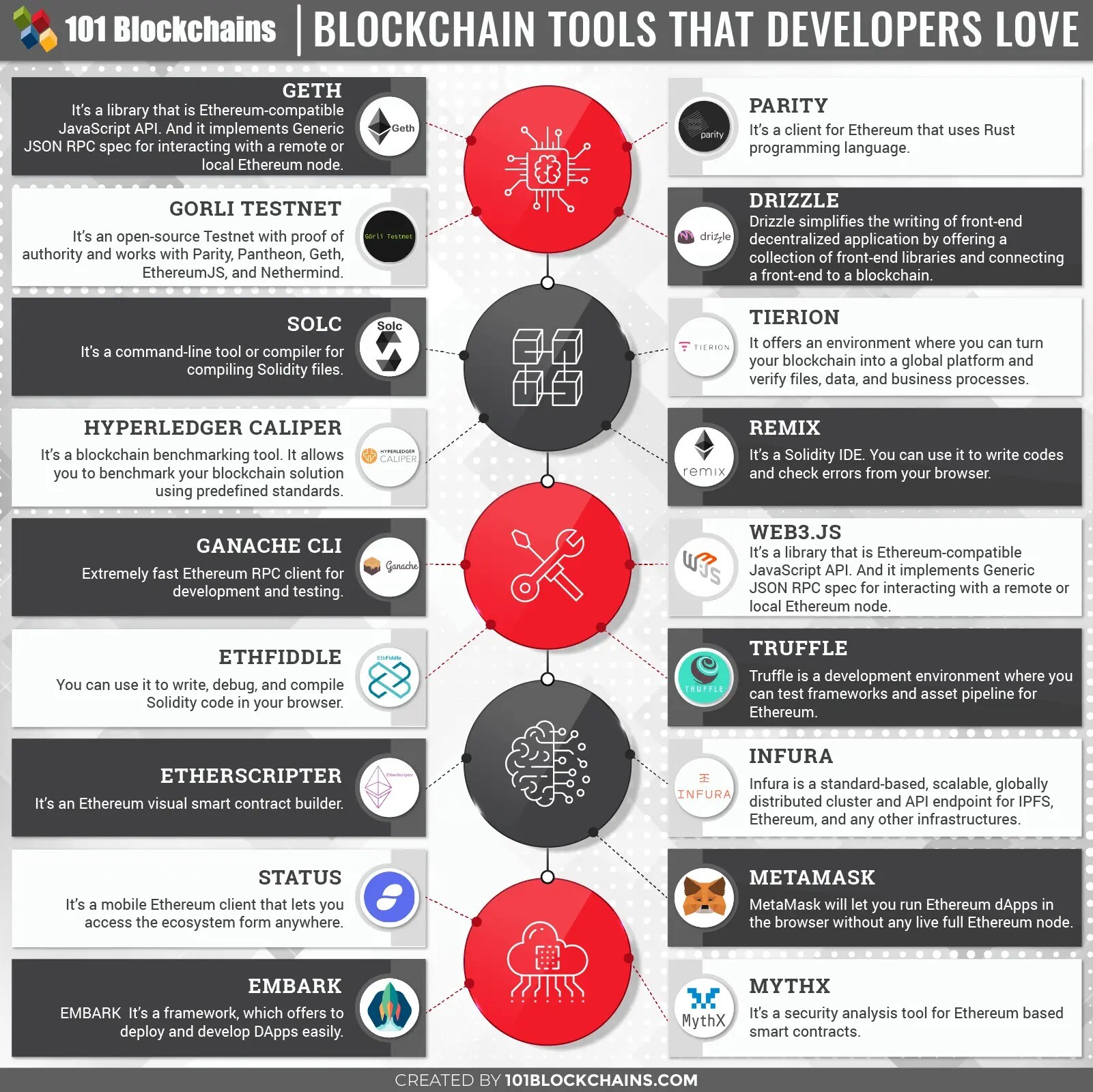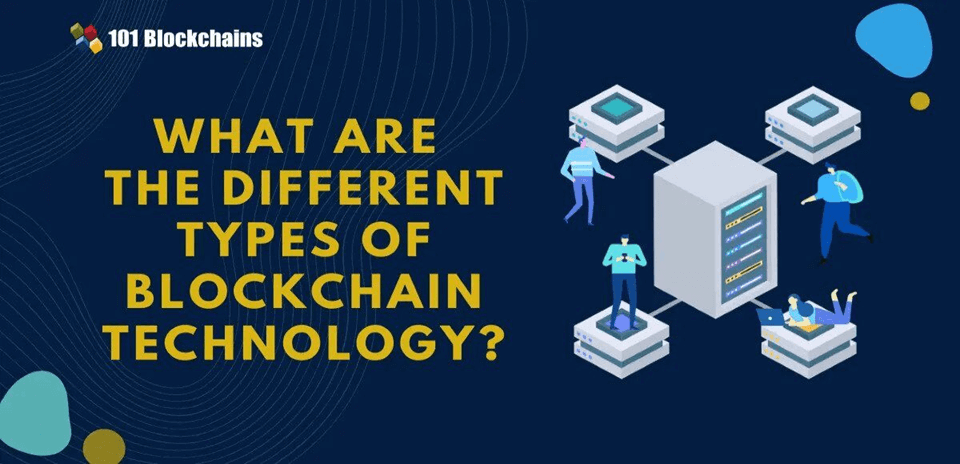Learn how blockchain truly works, master key definitions, and uncover what makes smart contracts so "smart." Dive into the fundamentals, gain valuable insights, and start your blockchain journey today!

- Reviews
Hasib Anwar
- on November 28, 2021
Blockchain Tools That Developers Love
When developing blockchain solutions, blockchain tools are a blessing. At present, the popularity of blockchain is rising drastically. So, there’s a blockchain development rush everywhere. There is no doubt that almost all companies would like to take full advantage of this opportunity.
And this is precisely where you fall in. If you are a blockchain developer, now you have the highest value in the market. But as the tech is entirely new and keeps on having more features, you must stay relevant. Thus, the use of blockchain tools can surely make your life much easier.
Blockchain Tools That Developers Love

Please include attribution to 101blockchains.com with this graphic. <a href='https://101blockchains.com/blockchain-infographics/'> <img src='https://101blockchains.com/wp-content/uploads/2019/11/Best-Blockchain-tools.jpg' alt='Best Blockchain tools='0' /> </a>
There are many blockchain tools for developer, but you have to know which ones are the top blockchain tools that all developers love. Let’s check out the list, shall we?
18 Blockchain Development Tools That Developers Love
Geth
Let’s start with Geth. Geth is a command-line tool that also runs a full Ethereum node in Go programming language. Basically, it comes with three interfaces –
- An interactive console
- A JSON-RPC server
- The command and subcommand line options
You can use Geth to do a lot of things in the blockchain. These blockchain development tools can –
- Transfer tokens between two addresses.
- Mine Ether token in the network.
- Explore the different history of the blocks in the ledger.
- Create smart contracts and can later run them on Ethereum Virtual Machine.
What Kind of Systems Would Support Geth?
When working with these enterprise blockchain development tools, you can use different operating systems such as Windows, Linux, and Mac. They all support this command-line tool. Additionally, Binary and Scripted also support its installation.
First of all, when you launch it, you can either connect it to a live blockchain network, or you can create a new one and then connect to that. But you need to remember that the second option would depend entirely on its settings.
For any reason, if you didn’t use any default values, then this tool will automatically connect you to the Ethereum mainnet.
Furthermore, with help from these blockchain tools for developer, you can make it function as a console and load certain commands and execute different objectives.
Anyhow, remember that when you will run Geth, it will automatically download the Ethereum distributed ledger, and it may take a long time to process. So, you might have to wait for several hours to days. That’s why it’s best to use an external hard drive to store all the information.
Build your identity as a certified blockchain expert with 101 Blockchains’ Blockchain Certifications designed to provide enhanced career prospects.
Drizzle
Let’s move on to the next one in our blockchain tools guide. Drizzle simplifies the writing of front-end decentralized application by offering a collection of front-end libraries. It also offers a Redux library for connecting a front-end to a blockchain. So, you will get fresh chain data for front-end application developments.
Features of Drizzle
- Reactive Ethereum Data Store
A Redux library is actually at the core of Drizzle. Using this, you can synchronize your transaction data, contract data, and many more.
- Generate Store or Use Existing Ones
In reality, you can use these blockchain tools for developers to generate a store, or you can also use any existing store of your own. All you have to do is to import sagas and reducers, and you’re set!
- Offers Underlying Functions
The best thing about this tool is that it extends web3 1.0’s contracts. So, you will get access to every method and property of web3.
- Component Library
In reality, they offer a library of React components that you usually use in dApp functions. So, tasks like generating input forms for smart contracts is an easy task.
- Modular Architecture
The overall architecture of this tool is modular. So, you can add any kind of feature or get rid of any kind of functionality as you wish. Furthermore, it includes two packages for using React; however, the core functions are within the Drizzle module. More so, if you know how to work with Redux, you can quickly develop an Angular library.
The three main components of Drizzle are –
Drizzle – It’s the core library for web3, contract, and account instantiation. Also, it can wire up the necessary synchronizations along with offering added contract functionalities.
Drizzle-react – This component offers a DrizzleConnect helper and a DrizzleProvider component for connecting to Drizzle with the React app.
Drizzle-react components – Additionally, you’ll get a library full of many useful components that would work as a dApp function. Mainly it includes ContractForm, ContractData, and LoadingContainer.
Thinking how much you can earn as a Blockchain Developer? As per reports, Blockchain developer salary is currently on rise, let’s get the insights of Blockchain Developer Salary.
Solc
When it comes to developing on Ethereum, all developers opt for stability. In reality, developers should always opt for it, especially when it comes to smart contract integrations. Solidity happens to be at the core of every smart contract on Ethereum.
Solidity is basically a trimmed down and object-oriented language and uses a syntax that’s mostly similar to ECMAScript. What the Solc tool can do in this regard is to convert it to a machine-readable format so that EVM can read it and execute it. You could think of it as a solidity compiler that revolves around two main principles –
- C++ coded solc.
- Solc-js that use Emscripten for cross-compiling the solc C++ straight to JavaScript.
Even though the two types of solidity compilers originated from the same source file, still they both can generate a different result. Furthermore, both of their command-line interfaces are different from each other. However, in comparison, solc-js is a bit slower than solc.
The best part is that Ethereum nodes tend to come with an implementation of solc. However, the solc package is actually a standalone module, and you can use it offline as well. Moreover, you can use solc.compile() as well because this one doesn’t need any external node to function properly.
Excited to learn the basic and advanced concepts of ethereum technology? Enroll Now in The Complete Ethereum Technology Course!
Remix
It’s a Solidity IDE. You can use Remix to write codes and check errors from your browser. In reality, it’s one of the blockchain development tools written in JavaScript. More so, you can use this tool like a compiler, mainly for small smart contracts. Also, if you are just starting to learn about Solidity, you should definitely give this tool a shot.
Once you go into the website’s default page, you’ll get a side screen that would allow you to write code right there in the browser! On the other screen, you can easily deploy your code on the blockchain platform.
Furthermore, the second screen will also help you interact with any functions you have written. It also supports the handlings are done locally or the browser. Anyhow, you can also do testing’s, debugging’s, distributions of smart contracts, and etc.
Also, the code analyzer would help you perfect your codes and get rid of any errors. So, it can be one of the greatest blockchain tools for developer is he/she is a beginner.
Start your blockchain journey Now with the Enterprise Blockchains Fundamentals
Ganache CLI
It’s actually an extremely fast Ethereum RPC client for development and testing. I have to say, this is yet another one of the good blockchain development tools out there. It was previously known as Testrpc but later came to be as GanacheCLI. In reality, it’s a NodeJS bundle that you can also customize.
Basically, it can replicate an entire Ethereum network on your computer. Also, you can call a function from the blockchain without any Ethereum nodes running on your PC.
Additionally, it offers these features for you to try out –
- Almost instant mining of transactions.
- No transaction fees.
- Customizing the mining speed or gas prices as you please and as many times you want.
- Recycling, instantiating or resetting all the accounts in the testnet for a defined amount of Ether.
- Very easy and simple Graphical User Interface from which you can overview all the events in the testchain.
Other Features
- You can see the status of all the accounts, including their private keys, addresses, balances, and transactions.
- Oversee the log outputs of Ganache blockchain along with responses and debug information.
- Just with a click, change the mining clocks.
- Get a block explorer to give you more clarity on how your system is working.
Excited to build your skill in Ethereum development by leveraging the ethers.js library? Enroll Now in Ethers.Js Blockchain Developer Course!
Truffle
Another one of the blockchain tools for developer is the development environment where you can test frameworks and asset pipeline for Ethereum – Truffle. Apparently, Truffle is quite popular among developers because it can make the development of the Ethereum framework a simple task.
Features
- Lifecycle Management of Smart Contracts
Apparently, this tool can manage your contract artifacts and also includes support for any custom deployments, complex Ethereum applications, and library linking.
- Contract Testing
You can test your contracts automatically and ensure that they develop quickly.
- Scriptable Migrations and Deployment
You can use this blockchain tool to write simplistic and manageable deployment scripts to anticipate your contracts change as time goes by. It will let your app to evolve and be relevant even in the future.
- Management of Network
You don’t have to manage any network artifacts once you start to use Truffle. Moreover, it will take care of those while you concentrate on dApp development.
- Highly Powerful Interactive Console
Well, interacting with contracts has never been easier. In reality, Truffle would allow you with a simple interface that can have your time and let you interact with your contracts.
- External Script Runner
You can use this blockchain tool to bootstrap all your contracts and run on the network without any issues.
EtherScripter
If you are a newbie in the blockchain development niche, then Ether scripting can be a difficult task for you. But with this type of blockchain analysis tools, you can code basic contracts quite easily. In reality, this blockchain tool would offer you a very interactive and fun interface to write all your codes.
Furthermore, you can simply drag and drop all the functions to make the smart smarts. It’s quite simple to use. However, at this moment, you can only use Serpent programming language in this type of blockchain analysis tools.
MetaMask
Another one of the great blockchain management tools is the MetaMask. With MetaMask, you can not only serve Ether or any other ERC-20 tokens on the network, but you can also interact with your decentralized applications. More so, it also lets you run it from your browser!
Furthermore, it’s extremely easy to add MetaMask as a Firefox or Google Chrome add-on and start using it right from the browser. After you install the app, you’ll get an Ethereum wallet added to your browser. It will store all the ERC-20 tokens for you.
For developers, this type of blockchain analysis tools won’t need any live Ethereum node to run. So, interacting with the Ethereum network space is a simple task.
Embark
If you want a blockchain development framework for your decentralized applications, then Embark can really help you out. In reality, this type of blockchain management tools will let you manage your dApps, along with giving you all the necessary tools to create and deploy a new one.
Additionally, you can create an independent html5 app that would use decentralized features. Furthermore, you can also create new smart contracts here and launch them in the JS code. The best part about this type of blockchain management tools is that they lookout for any changes you make in the contracts. If so, it will automatically modify contracts and then update the decentralized applications linked to them.
Smart contract migrations are also a plus point of this blockchain tool. In reality, for working on the platform, you can use any traditional language such as Meteor, Angular, React, and many more.
Gorli Testnet
You know the best way to fully test your network without going live would be to harness any testnets. And this where this type of blockchain analysis tools comes in. Gorli Testnet is one of the popular ones out there. Here, you can deploy your dApps and experiment with smart contracts.
More so, you can use it across all client blockchain implementations and get high reliability and availability. Anyhow, Gorli is actually a proof-of-authority cross-client testnet that works with Parity, Pantheon, Geth, EthereumJS, and Nethermind.
However, it’s open-source and is a community-based project.
Parity
Parity is another one of the blockchain management tools that’s built for mission-critical use. It’s a client for Ethereum that uses Rust programming language. More so, this blockchain tool offers the core infrastructure needed for reliable and speedy services.
You can build your very own customizable blockchains for enterprises, private use, or for research purposes, as well. You’ll get –
- Modular and clean code base and customization
- Minimal storage and memory footprint
- Use Warp Sync to synchronize in hours
- Very advanced CLI-based client
- Different and pluggable consensus protocols
- High level of access control and privacy features
- Fast transactions
The best part about this blockchain tool is that it’s 100% reviewed, and the developers do routine codebase checkups to get rid of any bugs or issues.
Hyperledger Caliper
It’s a blockchain benchmarking tool. It allows you to benchmark your blockchain solution using predefined standards. In reality, with this type of blockchain analysis tools, it can get really easy to know whether your blockchain platforms are up to the standards or not.
Once you predefine your set of use cases, it can start working its magic. In reality, you’ll also get reports on transaction latency, Transactions per Second, resource utilization, and many more.
However, you have to know for Caliper to help you out; you need to build your blockchain solution on Hyperledger.
But as you can see, it does not have any default set standards. But why is that? Well, blockchain technology is quite diverse, and every single platform is different. It’s utterly difficult to analyze all the platforms under the same pre-defined set.
So, instead, you can set up the standards based on your industry and then run the tool to see how it performs. That’s why it’s one of the handiest blockchain management tools for the developers.
Want to learn the basic and advanced concepts of Blockchain and Hyperledger Fabric? Enroll Now: Getting Started with Hyperledger Fabric Course
Tierion
Tierion offers an environment where you can turn your blockchain into a global platform and verify files, data, and business processes. These kinds of tools for blockchain will help you construct a valid database and help you distribute those data to the ledger.
Furthermore, this blockchain tool also offers ChainPoint that can produce receipts and record data. And so, you don’t need any intermediates to verify the information. Anyhow, with the help of this blockchain tool, you also can combine the Tierion API and ChainPoint to timestamp every data to finalize the verification process.
It’s capable of producing millions of proof every second. Furthermore, this type of blockchain technology tools offer accuracy by –
- Getting all the data from the Network Time Protocol servers
- Using available data from the National Institute of Standards and Technology
- Linking anchor nodes to the Ethereum or Bitcoin blockchain
EthFiddle
If you are a developer that started with Solidity, you may know that there aren’t many blockchain technology tools for working with this language. However, to help you out and offer you similar tools like JSFiddle or Go Playground, the Loom Network introduced EthFiddle.
EthFiddle is one of the tools for blockchain development that offers rapid testing and prototyping. It’s actually a Solidity IDE on your browser. In reality, this blockchain tool is capable of testing, creating, debugging Solidity codes for your smart contracts.
Additionally, you can also share the permalink of your code with just a click. So, you see if you are new to the Solidity environment, you might want to give EthFiddle a try.
Preparing for a Blockchain Developer Interview? Here’re the top Blockchain Developer Interview Questions you should go through to crack the interview.
Web3.js
Web3.js is one of the tools for blockchain development that helps you to develop clients for interacting with Ethereum blockchain. Basically, it’s a library that is Ethereum-compatible JavaScript API. And it implements Generic JSON RPC spec for interacting with a remote or local Ethereum node.
So, with this, you can do tasks like sending Ether between address, write and read smart contract data, develop smart contracts, and many more.
As the blockchain tool runs on JavaScript language, you can use it in any kind of web browser. But you’ll need Ethereum node that can access the Ethereum network via HTTP for using this type of blockchain technology tools. I can suggest using MetaMask extension with Web3.js for connecting to the Ethereum network.
Curious to develop an in-depth understanding of web3 application architecture? Join the Standard & Premium Plans and Enroll Now in Web3 Application Development Course!
Status
Status is another one of the tools for blockchain development. In reality, it’s a multi-purpose communication tool that comes with a decentralized crypto-wallet, peer-to-peer messenger, and Web3 browser. Basically, it’s a mobile Ethereum client that lets you access the ecosystem from anywhere.
As for the messenger, you can join any public channels and send and receive messages from another user. Also, the high level of encryption makes it impossible for anyone to get access to your messages.
Furthermore, with the help of the blockchain tool, you can interact with your decentralized applications and use the integrated wallet.
From the browser, you can directly access the networks, marketplaces, and many more. Also, with the extension tool, you can add up features to this mobile client.
Infura
Infura is a standards-based, scalable, globally distributed cluster and API endpoint for IPFS, Ethereum, and any other infrastructures. In reality, this type of tools for blockchain development is made only for developers. So, you can quickly use this tool to connect your app with their instant access APIs.
Apparently, this blockchain tool supports JSON-RPC over WebSocket interfaces and HTTPS offering subscription and request based connections. More so, with just a single URL, you can start using Infura. The team behind the tool would take care of all the upgrades and network changes so that you can focus on your creation.
Mythx
There’s a high demand for smart contract development and decentralized applications. However, there aren’t many blockchain technology tools that offer a full suite. This is where MythX comes in. Basically, it’s a security analysis tool for Ethereum based smart contracts. More so, with this blockchain tool, you will get dynamic and static analysis all in one tool suite.
There are many products for you to test out, such as Truffle, Amberdata, Alethio, Visual Studio Code, Remix, and Embark. So, you can easily couple this blockchain tool with the other tools.
Furthermore, it can detect security issues quite efficiently and is highly scalable.
Aspiring to make a lucrative career as a blockchain engineer but not sure how? Check the detailed guide Now on How To Become A Blockchain Engineer
Conclusion
Blockchain technology tools can really save your time and make your blockchain development process easier. As a developer being efficient in blockchain adoption is a must, and a deep understanding of the popular blockchain development tools can help greatly.
In this guide, I’ve given all the tools that developers are loving these days. So, now that you know what these different blockchains tools are, it’s time for you to dive in and start developing.
*Disclaimer: The article should not be taken as, and is not intended to provide any investment advice. Claims made in this article do not constitute investment advice and should not be taken as such. 101 Blockchains shall not be responsible for any loss sustained by any person who relies on this article. Do your own research!






